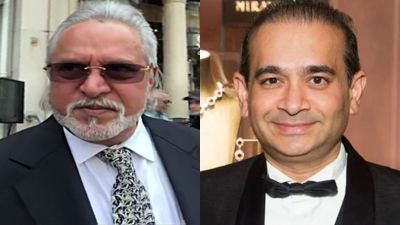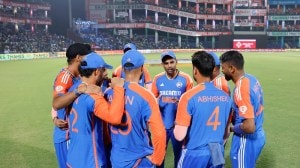Mumbai Nightmares Dont End
Another blast,still looking for clues.
None of the blasts or suspected terror strikes after 2008 has been solved yet as investigators begin their hunt for the perpetrators of Wednesdays attack
RAHUL TRIPATHI
Since 2006,almost every terror incident has been accompanied by emails from the Indian Mujahideen,claiming responsibility for the attacks. But no one has claimed responsibility for three recent attacksWednesdays blasts in Mumbai,an aborted explosion outside the Delhi High Court in May this year and last years German Bakery blast.
Is this then a sign of the emergence of a new terror group or even a new terror module with old recruits?
These anonymous attacks and the precision with which they have been carried out have outwitted Indian intelligence agencies. Union Home Minister P Chidamabaram says there have been fewer terror strikes since the 26/11 attacks in Mumbai in 2008 and that many of them were nipped in the bud. However,none of the blast cases since 2008 have been solved.
Experts believe that terrorists are operating in newer ways. Ajai Sahni of The Institute for Conflict Management says,The recent incidents reveal a new pattern where modules or groups are not based in the city where they carry out the strikes. They can come from anywhere and place a bomb in any location. The planning may have been done outside but their targets are cities like Delhi and Mumbai.
Sahni says that the use of ammonium nitrate,which is readily available,in the making of bombs has made their job easier. Except for detonators,everything that is required to make a bomb is easily available in the open market. All you need to do is assemble and plant the bomb. The groups do not need local support and that has made the job of security agencies tougher, he says.
The creation of the National Investigation Agency (NIA) as a central anti-terror agency after Mumbai 26/11 does not seem to have helped. An information vacuum continues to exist among intelligence agencies,state police and other machinery of the government.
The NIA has problems of its own,a crippling shortage of staff to begin with as not many officers are willing to join the agency. Besides,it has come under attack from Opposition parties for the speed with which it is probing Hindu terror cases,including the Samjhauta,Mecca Masjid and Ajmer blasts. However,there are doubts about the probe into the Samjhauta Express blasts case,which killed nearly 60 people.
Many believe an intelligence system should be based on policing devised from the constabulary rather than the creation of a national agency that gathers case files from the local police.
This is an argument that seems justified in light of the manner in which investigations into some of the recent attacks have been carried out.
The German Bakery blast in Pune last year,which killed 17 people,remains a mystery. The Maharashtra ATS had claimed to have solved the case with the arrest of one person,but their interrogation of the suspect led them nowhere. The government is now planning to hand over the case to the NIA.
The 2006 Malegaon blasts case,in which around six Muslims from the town were arrested by the state police,has been handed over to the NIA.
But the agenciesfirst the Central Bureau of Investigation and then NIAhave not been able to gather enough evidence in the case and have not been able to give a clean chit to the accused who are believed to have been wrongly framed.
Similarly,the case of a low-intensity twin explosion outside the cricket stadium in Bangalore last year continues to be a mystery.
After every recent blast,the needle of suspicion has pointed to the Indian Mujahideen,a homegrown group with links to the Lashkar-e-Toiba. The outfit was behind a series of bombings from 2006 to 2009,but while their operations have been marked by a swift claim of responsibility,of late,that has dried up.
The last time IM claimed responsibility for a blast was in December 2010 when an explosion killed a girl in Varanasi. The case remains unsolved but media groups got an e-mail claiming responsibility for the blast and attributing it the demolition of the Babri Masjid.
Again,just before the Commonwealth Games in Delhi in 2010,two Taiwanese men were shot at outside Jama Masjid mosque in Old Delhi. Then too,IM claimed responsibility as retribution for the Batla House Encounter but the Delhi Police was not able to gain any lead.
The September 28,2008,low intensity explosion at the Mehrauli flower market on the outskirts of Delhi,which killed two persons,remains unsolved. In March 2010,a similar explosion was reported near Ambavatt complex in Mehrauli. The explosive was reportedly packed in a plastic bottle. Though cops had initially suspected the involvement of a Bangladeshi group,subsequent investigations proved otherwise.
On May 25 this year,a crude device planted beneath a parked car outside the Delhi High Court failed to go off after its detonator malfunctioned. There has been no movement in the case in the last month and a half. Nearly two dozen such low-intensity blasts remain unsolved in the last eight years.
A long road to justice
Barring the trial of Ajmal Kasab,almost every other terror case in Mumbai has seen inordinate delays in courts
MAYURA JANWALKAR
Mumbai bled yet again on July 13 after explosions ripped apart three of its many busy corners. While investigators set off on a new terror trail,wounds as old as that of 1993 remain unhealed.
The trial of Pakistani national Mohammed Ajmal Amir Kasab has been the fastest on the road to justice with the Bombay High Court confirming the death sentence that a Mumbai special court handed out in May 2010,within two years of the attacks on Chhatrapati Shivaji Terminus,Hotel Taj,Oberoi,Nariman House and Cafe Leopold on November 26,2008.
However,the speed with which the Kasab case has moved is an exception. This is the city that has seen one of the longest trials in the worldthe 1993 serial blasts case concluded after 13 years,but the Supreme Court is yet to give its finality to the verdict. Other cases of terror attacks are at various stages of trials and appeals.
Retired Supreme Court judge B N Srikrishna said the volume of a case cannot be an excuse for inordinate delays in trial. If every courtthe court of trial,appeal and the apex courtcan conclude the proceedings before it in one year,it would be ideal. But we are not living in an ideal world, he said.
Defence lawyer Satish Maneshinde feels there are enough laws in the country to deal with terror and their effective implementation would ensure speedy justice. There needs to be at least a five-fold increase in the number of judges, he said.
Prolonged trials are as unfair to the accused as they are to victims of terror,said Maneshinde,who defended actor Sanjay Dutt in the 1993 bomb-blast trials. If an accused remains in jail through the trial and is acquitted in the end,no compensation can bring back the years he spent in jail. And even if he is released on bail,there is constantly a sword hanging over his head, he said.
Here are some of the key cases hanging fire:
Mumbai serial bomb blasts,1993
On March 12,1993,13 bombs exploded between 1.30 p.m. and 3.35 p.m.,leaving 257 people dead and 713 injured. The trial began in 1995 and continued,with intervals,for 11 years. The court heard 686 witnesses and collected 35,000 pages of evidence. Ejaz Pathan and Mustafa Dossa,both accused in the case,were brought in from Dubai in 2003 and gangster Abu Salem was extradited in 2005 from Portugal. Their trial in the case is still pending. The prime accusedgangster Dawood Ibrahim,Chhota Shakeel and Tiger Memonare still at large.
After 3,200 days of trial,a special TADA court convicted 100 of the 129 accused,including actor Sanjay Dutt who was held guilty under the Arms Act,and four members from the family of Tiger Memon. Twelve of the accused were handed out the death sentence. The blasts trial has about 35,000 pages of evidence given by 686 witnesses and 9,162 pages of statements given by 129 accused.
However,the convictions in the case have been challenged before the Supreme Court. The apex court was supposed to commence the final hearing in the case on March 29,but its yet to start.
Our judiciary gives everyone a fair trial but victims like me bear the brunt of these acts of violence. I have undergone more than 40 surgeries after the blasts and even now,there are glass pieces in my body. I will get closure only when the guilty are punished, said Kirti Ajmera,54,a property consultant injured in the blast at the Bombay Stock Exchange.
Gateway of India-Zaveri Bazaar twin blasts,2003
The handiwork allegedly of homegrown terrorists seeking revenge for the killing of Muslims in Gujarat in 2002,the twin attacks on August 25,2003 led to the killing of 53 people and injured at least 150. Hanif Sayed Anees,his wife Fehmida and Ashrat Ansari were found guilty of planting two bombs in taxis that exploded at the Gateway of India and Zaveri Bazaar. Six years after the incident,a special POTA court held the three accused guilty and sentenced them to death. Hanif and Fehmidas 16-year-old daughter was let off in the case. The Lashkar-e-Toibas role in the twin blasts was revealed by an accused-turned-approver,who told the court that a conspiracy meeting,which was attended by the outfits activists from Pakistan,was held in Dubai.
Malegaon bomb blasts,2006 and 2008
Nine men were accused of plotting the blasts that claimed 37 lives in the textile town of Malegaon on September 8,2006. The CBI took over the investigations in December 2006 but for the next three years,it did not submit any report on the case. In February 2010,it said there was no evidence to charge the nine men jailed for the Malegaon blast,but stressed that it believed they are responsible for the attack. However,in light of the statement made by Swami Aseemanand before a Delhi court that the attacks were plotted by Hindu right-wing terror groups,the nine accused Muslims sought bail.
In June this year,the National Investigation Agency (NIA) took over both the Malegaon blast case of 2006 and that of September 29,2008,when six people were killed. The NIA will question three of the 13 accusedLt Col Prasad Purohit,Dayananad Pandey and retired Major Ramesh Upadhyayain the 2008 blasts case,after which it is likely to file a report before a special court. A date for the trial to start is still nowhere in sight.
Mumbai local train blasts,2006
The citys second tryst with serial bombs claimed 187 lives and injured close to 800. Seven bombs exploded within 11 minutes on July 11,2006. Thirteen alleged Lashkar recruits were arrested by the Anti-Terrorism Squad and booked under the stringent Maharashtra Control of Organised Crime Act (MCOCA). After the case got stalled for nearly two years,with one of the accused Kamal Ansari challenging the constitutional validity of a section pertaining to insurgency under MCOCA,it was only last year in May that the Supreme Court rejected the petition and the trial resumed.
With only police officers left to be examined in the case,the trial is likely to be concluded by the end of 2011,four years after the incident. al-Qaedas manual gives tips to recruits and tells them how to use provisions in Indian law to their advantage. They are taught how to make allegations against investigating agencies and how to mislead the prosecution. They are told to use these tactics to delay or even derail the trial, said Ujjwal Nikam,prosecutor in high-profile terror cases in Maharashtra.
Mumbai attacks,2008
The death sentence handed out to Kasab is in the last round of litigation before the Supreme Court. The Mumbai police crime branch,which was left red-faced after both the trial court and the Bombay High Court acquitted Kasabs alleged Indian aides Faheem Ansari and Sabahuddin Ahmed,is hoping to get the order of the acquittal reversed in the apex court.
Pune German Bakery blast 2010
In September 2010,the ATS chargesheeted Mirza Himayat Inayat Baig,allegedly the chief of Lashkars Maharashtra unit,and six others in the German Bakery blast case. The bomb blast in Punes popular eatery on February 13,2010,killed 17 and injured close to 50 people. However,the case has been stagnant after the 2,700-page chargesheet was filed.
(With inputs from Joshua Patnigere)
Photos





- 01
- 02
- 03
- 04
- 05

























